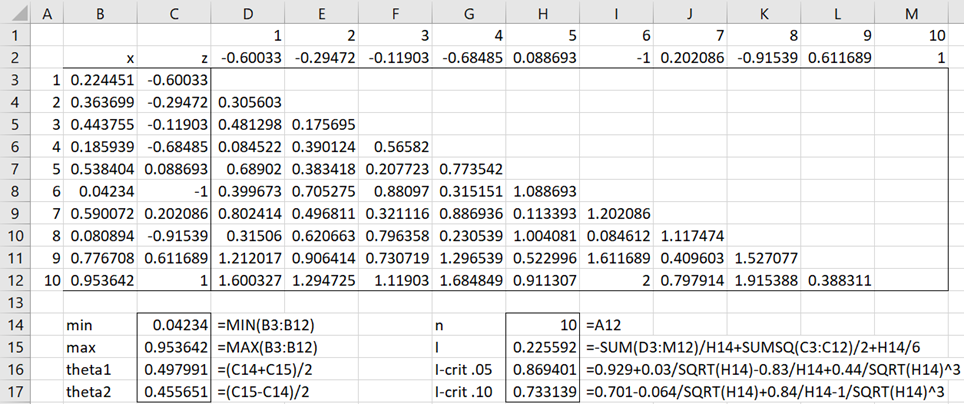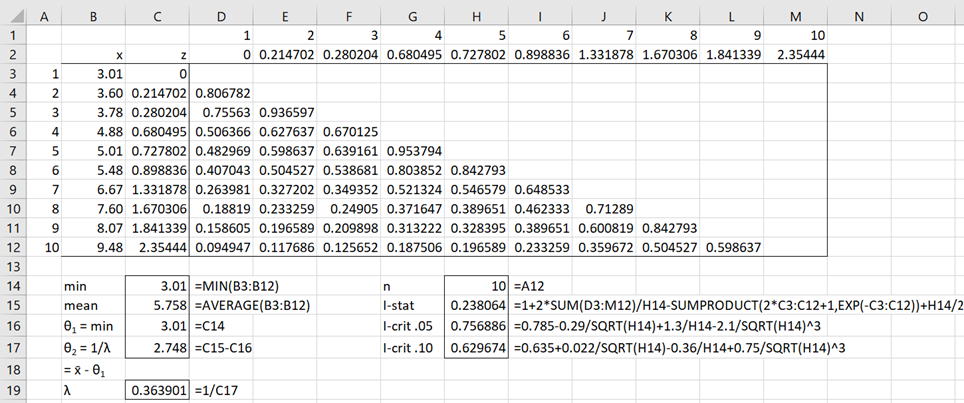We now extend the goodness-of-fit test based on the characteristic function to uniform and exponential distributions.
Uniform Distribution
For data X = {x1, …, xn} from a (continuous) uniform distribution on (a, b) with pdf
we use the estimates
a = min X b = max X
Now define
Thus
Define
We use the test statistic
The critical values Iα of this statistic for 10 ≤ n ≤ 400 are
Henceforth, we will abbreviate these critical values as
If If I ≥ Iα, then we reject the null hypothesis that the data comes from a uniform distribution.
Example 1: Determine whether the data in column B of Figure 1 are uniformly distributed.
The analysis is also shown in Figure 1. Note that cell C3 contains the formula =(B3-C16)/C17 and cell D3 contains the formula =IF(D$1<$A3,ABS($C3-D$2),””). The other formulas in C3:M12 are filled in as explained in Example 1 of Goodness-of-Fit Test based on the Characteristic Function.
Figure 1 – GoF for uniform distribution
We see from Figure 5 that I = .225592 < .733139 = I.10, and so we can’t reject the null hypothesis that the data is uniformly distributed.
We get the same results as shown in range G14:H17 via the array formula =ICF_GOF(B3:B12,”uniform”,TRUE). See Goodness-of-Fit Test based on the Characteristic Function for a description of the ICF_GOF function and its arguments.
Note that if we test the 10 data elements in B2:B11 of Figure 1 via the formula =ICF_GOF(B2:B11,”uniform”,TRUE), we obtain I-stat = 2.963459 > .869401 = I.05. This is a significant result, providing evidence that the data is not uniformly distributed.
Exponential Distribution
For data X = {x1, …, xn} from an exponential distribution with pdf
We use the following MLE parameter estimates
The test statistic for this test is
The critical values when μ is unknown are
When μ is known then use the above table assuming n = 0 (i.e. I.05 = .785 and I.10 = .635).
Example
Example 2: Decide whether the data in B3:B12 of Figure 2 fits an exponential distribution.
This example comes from the referenced textbook. Figure 2 describes the analysis. Note that cell C3 contains the formula =(B3-C16)/C17 and cell D3 contains the formula =IF(D$1<$A3,EXP(-ABS($C3-D$2)),””). The other formulas in C3:M12 are filled in as explained in Example 1.
Figure 2 – GoF for Exponential distribution
We see from Figure 2 that I = .238064 < .629674 = I.10, and so we can’t reject the null hypothesis that the data is uniformly distributed with pdf
f(x) = .363901e–.363901(x–3.01)
We get the same results as shown in range G14:H17 via the array formula =ICF_GOF(B3:B12,”expon”,TRUE).
If instead, we know that μ = θ1 = 0, then using the worksheet formula =ICF_GOF(B3:B12,”expon”,TRUE,,0) we see that I = 1.189405 > 785 = I.05, and so p-value < .05, which is a significant result. Here we estimate λ = 1/5.758 = .173671. Thus, we conclude that the data doesn’t follow an exponential distribution, estimated by
f(x) = .173671e–.173671x
Examples Workbook
Click here to download the Excel workbook with the examples described on this webpage.
Reference
Epps, T. W. (2014) Probability and statistical theory for applied researchers
https://books.google.co.uk/books?id=NCs8DQAAQBAJ&pg=PR4&lpg=PR4&dq=Epps,+T.+W.+Probability+and+statistical+theory+for+applied+researchers&source=bl&ots=GxU40vCNHu&sig=ACfU3U0vgZZndBfjMMmqYPQuCXAJf2jrow&hl=en&sa=X&ved=2ahUKEwiw5_3R-4KCAxVCgFwKHa2fA384FBDoAXoECAQQAw#v=onepage&q=Epps%2C%20T.%20W.%20Probability%20and%20statistical%20theory%20for%20applied%20researchers&f=false





